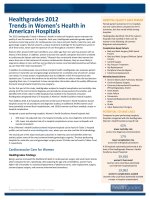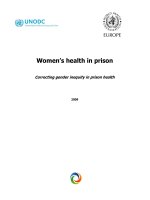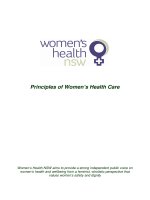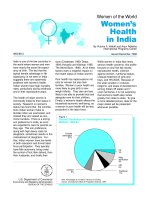Nurse Practitioner Primary Care Competencies in Specialty Areas: Adult, Family, Gerontological, Pediatric, and Women’s Health potx
Bạn đang xem bản rút gọn của tài liệu. Xem và tải ngay bản đầy đủ của tài liệu tại đây (229.5 KB, 84 trang )
Nurse Practitioner
Primary Care
Competencies in
Specialty Areas:
Adult, Family, Gerontological,
Pediatric, and Women’s Health
April 2002
US Department of Health and Human Services
Health Resources and Services Administration
Bureau of Health Professions
Division of Nursing
COVER 2
The views expressed in this document are solely those of the National Organization of Nurse
Practitioner Faculties in partnership with the American Association of Colleges of Nursing. This document is not a statement of the policy, position or views of either the United States Department of
Health and Human Services (HHS) or the United States Government. HHS neither endorses nor
requires compliance with the contents of this document.
Nurse Practitioner
Primary Care Competencies
in Specialty Areas:
Adult, Family, Gerontological, Pediatric, and Women’s Health
April, 2002
Prepared for:
Department of Health and Human Services
Health Resources and Services Adminstration
Bureau of Health Professions
Division of Nursing
5600 Fishers Lane, Room 9-35
Rockville, MD 20857
Prepared under Contract Number:
HRSA 00-0532(P)
Submitted by:
The National Organization of Nurse Practitioner Faculties (NONPF)
www.nonpf.com
in partnership with
The American Association of Colleges of Nursing (AACN)
www.aacn.nche.edu
PROJECT TEAM
M. Katherine Crabtree, DNSc, ANP, APRN, BC
Co-Project Director
National Organization of Nurse Practitioner Faculties
Joan Stanley, PhD, RN, CRNP
Co-Project Director
American Association of Colleges of Nursing
Kathryn E. Werner, MPA
Project Staff
National Organization of Nurse Practitioner Faculties
Emily Schmid, MFS
Project Staff
American Association of Colleges of Nursing
iii
TABLE OF CONTENTS
Executive Summary .................................................................................................................................................1
Section I: Introduction...............................................................................................................................................3
Section II: Methods...................................................................................................................................................7
Section III: Nurse Practitioner Primary Care Competencies in Specialty Areas.....................................................13
Adult Nurse Practitioner Competencies .....................................................................................................17
Family Nurse Practitioner Competencies ...................................................................................................21
Gerontological Nurse Practitioner Competencies ......................................................................................25
Pediatric Nurse Practitioner Competencies................................................................................................29
Women’s Health Nurse Practitioner Competencies ...................................................................................35
Section IV: Domains and Core Competencies of Nurse Practitioner Practice .......................................................39
References .............................................................................................................................................................49
Appendices
Appendix A:
Endorsements ...................................................................................................................A-1
Appendix B:
National Panel ...................................................................................................................B-1
Appendix C:
Organizations Represented on National Panel ................................................................C-1
Appendix D:
Organizations Represented on Validation Panel ..............................................................D-1
Appendix E:
Definition of Terms.............................................................................................................E-1
v
EXECUTIVE SUMMARY
In August 2000, the Department of Health and Human Services, Health Resources and Services Administration,
Bureau of Health Professions, Division of Nursing, funded the National Organization of Nurse Practitioner Faculties for this contract to develop consensus-based primary care competencies for nurse practitioners in the areas
of adult, family, gerontological, pediatric, and women’s health practice. Educational programs in these five areas
prepare over three-quarters of all nurse practitioner graduates. The National Organization of Nurse Practitioner
Faculties, in partnership with the American Association of Colleges of Nursing, sought broad national participation
and provided joint leadership to identify and validate primary care competencies for the five practice areas.
The National Panel (see Appendices B and C), representing nine organizations of the five primary care nurse practitioner specialties of adult, family, gerontological, pediatric, and women’s health, as well as the credentialing and
certifying agencies for nurse practitioners, identified competencies that capture the essence of the needs for the
population(s) served in each specialty areas. The panel utilized previously developed core and specialty competencies, role delineation studies, and other existing literature as the basis for their work.
The Validation Panel (see Appendix D), broadly representing leaders from nursing practice, education, and
accreditation organizations, reviewed the primary care competencies to assess their relevance, specificity, and
comprehensiveness for the five practice areas. The Validation Panel overwhelmingly validated the work of the
National Panel, suggesting only minor adjustments and additions before finalization of the consensus competencies in fall 2001.
This document describes entry-level competencies of graduates prepared as adult, family, gerontological, pediatric, and women’s health primary care nurse practitioners (see Section III). The intent is for educational programs
to use these specialty competencies in conjunction with the core competencies (see Section IV), as well as the
graduate and advanced practice nursing core content, to shape nurse practitioner curricula. These competencies
will set the national standard for guiding program development in the five different primary care focus areas and
provide the model for the future development of competencies for other specialty-focused nurse practitioner roles.
1
Section I:
Introduction
3
INTRODUCTION
In 1998, the enactment of Title VIII, Nursing Workforce Development (Health Professions Education Partnerships
Act of 1998, P.L. 105-392, November 13, 1998) focused federal attention on the quality of education programs supported by this Title. As part of the implementation of this legislation, in August 2000, the Department of Health and
Human Services, Health Resources and Services Administration, Bureau of Health Professions, Division of Nursing, funded this project. The National Organization of Nurse Practitioner Faculties (NONPF) and the American Association of Colleges of Nursing (AACN) directed this project to develop national, consensus-based, nurse practitioner primary care competencies in the specialty areas of adult, family, gerontological, pediatric, and women’s health
practices. The project was undertaken to lay the foundation for identification of competencies in all areas of nurse
practitioner primary care practice, promoting high quality and consistency in educational programs.
Background
In 1990, NONPF released the first set of core competencies for all nurse practitioner graduates within a framework
of five domains and corresponding competencies. These competencies evolved from the work of Patricia Benner
(1984), who described domains and competencies for advanced nursing practice, and the research of Karen
Bryckzynski (1989), who explored the clinical practice of nurse practitioners. NONPF adapted the domains from
Bryckzynski and incorporated additional nursing literature to develop and further identify nurse practitioner competencies. With input from a coalition of 14 different nursing organizations and extensive input from nurse practitioner faculty, NONPF updated the core competencies and program standards for nurse practitioner education in
1995. This work featured the addition of one domain and new competencies. Further updating of the core competencies in 2000 by NONPF resulted in the identification of a seventh domain.
The core competencies for nurse practitioner graduates build upon nursing knowledge and require graduate level
education to achieve an advanced level of nursing practice. AACN outlined this graduate curriculum foundation for
advanced practice nursing (AACN, 1996). As described by AACN, advanced practice nursing preparation includes
graduate nursing core content (e.g., research, health policy, ethics, and more) and advanced nursing practice content (e.g., advanced health assessment, advanced physiology and pathophysiology, and advanced pharmacology).
Specialty content for nurse practitioner education focuses on diagnosis and management content appropriate to
the population served, clinical practice, and the role of the specialty area. Several professional nurse practitioner
and nursing organizations, as well as the federal government, are interested in the identification of competencies
or guidelines in various specialty areas of nurse practitioner practice as a means of designating educational outcomes to promote patient safety. Until now, national, consensus-based competencies for these nurse practitioner
specialties did not exist. This project resulted in the first time availability of comprehensive competencies for the
five primary care specialties that describe over 80% of all nurse practitioner graduates.
Standard Setting
Through widespread dissemination and implementation, the core competencies are a gold standard for maintaining and shaping quality graduate degree educational programs. The competencies guide nurse practitioner curriculum development and revision nationally, as well as influence credentialing and accrediting bodies, health policy makers, and the federal government’s funding of nurse practitioner programs. They also serve as a model for
international nursing organizations developing their own educational framework for nurse practitioner educational
preparation. Their wide-reaching sphere of influence has shaped quality nurse practitioner education.
The expectation is for the competencies in the specialty areas of adult, family, gerontological, pediatric, and
women’s health practices to promote access to quality primary care practice. The nurse practitioner core and primary care specialty area competencies, combined with the graduate and advanced practice core content areas as
a total package, provide guidance to educational programs preparing clinicians in these practice areas. These specialty competencies offer potential employers, consumers, and students a clear set of expectations regarding the
nurse practitioner role and these areas of specialty practice.
5
However, as a nurse practitioner gains experience, his/her practice may include more advanced and additional
skills and knowledge not included in these entry-level competencies. In addition, as the nurse practitioner gains
experience, the settings or role in which s/he practices may differ from those described for the entry-level practitioner. Therefore, these competencies describe the standard for nurse practitioners as they enter practice rather
than the standard of behavior expected of experienced nurse practitioners.
Competency Based Higher Education
Aside from the goal of promoting high quality and consistency in nurse practitioner education, another impetus for
this project is a national trend for professions and higher educational programs to define their purposes and goals.
“In education, the real outcome should be defined in educational terms, not in terms of money or jobs. But the message is clear. Institutions of higher learning are going to have to do a better job of explaining what they are asking
people to pay for, and what the value of it is” (Chauncey, 1995).
In the past, credentialing, certification, and accreditation emphasized the amount of program resources and
description of processes, such as time-on-task, as indicators of quality. Previously professions focused more on
processes rather than on demonstration of skills needed to function in the role after graduation. Now and in the
future, clear statements of competencies and evidence of assessment of how well these competencies are met are
and will be the critical emphasis of program and student reviews.
The National Postsecondary Education Cooperative (NPEC) under sponsorship of the U.S. Department of Education is one of several organizations calling for the outline and implementation of competencies. NPEC defined
competency “as a combination of skills, abilities, and knowledge needed to perform a specific task” (U.S. Department of Education, 2000). Competencies are the domain or body of knowledge and skills that essentially define a
profession or discipline. This domain of competencies guides training programs, provides expectations for employers, and drives the nature of assessment instruments and performance standards for credentialing institutions, certifying agencies, and accrediting organizations (Erwin & Wise, 2001).
Implementation of the Competencies
The demand for competency-driven education at the national level signifies the importance of this project because
it identifies competencies for nurse practitioner educational preparation. The competencies delineate the consistent outcomes for the beginning preparation of nurse practitioners in primary care roles; however, this model can
serve as the framework for developing competencies in all nurse practitioner areas of practice. Furthermore, this
model may be useful in other areas of advanced practice nursing and within other health disciplines.
The extent to which these competencies influence primary care practice depends on their adoption by nurse practitioner educational programs as the basis for student outcome evaluation. Educational programs are obligated to
prepare their graduates to meet the evolving demands in the work place. In today’s market, this task includes
preparing a valuable and knowledgeable worker for the health care delivery system. A comprehensive, competency-based education ensures that graduates have the ability to apply their knowledge, judgment, and skills in their
practice roles. The competencies in these five primary care specialty areas provide the framework for educational
design. However, nurse practitioner programs face the challenge of developing effective assessment and evaluation tools needed for successful transition to the competency-based curriculum. Educators need reliable and valid
measures to evaluate the performance of the student.
This project advances the profession by building on the existing work done in this area by nursing and nurse practitioner organizations and by creating a national consensus for these primary care competencies in specialty areas.
The challenge of the future is to ensure that the competencies remain current for primary care practice. The methods used in this project provide a structure for broad-based, periodic review, which will preserve the national consensus for the competencies of nurse practitioner graduates entering primary care specialty areas of practice.
6
Section II:
Methods
7
METHODS
Overview
NONPF partnered with AACN to provide leadership in developing the national, consensus-based primary care
competencies in five specialty areas. The Division of Nursing (US DHHS, HRSA, BHPr) awarded a contract in late
summer 2000 to support the development and validation of the competencies with a goal of completion and dissemination by early 2002.
NONPF and AACN outlined two distinct phases to the project. In phase one, a group of representatives from the
NP certifying and specialty organizations, the National Panel, would review the existing body of work relative to
competencies in the five specialty areas and develop consensus-based competencies. Upon the completion of this
work, phase two would involve a group of representatives from NP practice and education, the Validation Panel, to
review and evaluate the specialty competencies. The National Panel would utilize the feedback from the Validation
Panel to finalize and reach consensus on the competencies. NONPF and AACN would seek endorsement of the
primary care competencies in the five specialty areas by the nurse practitioner and nursing community at large
before starting broad-based dissemination for implementation in the educational programs.
The organizations identified a joint project team to implement the project. M. Katherine Crabtree, DNSc, ANP, professor in the School of Nursing of the Oregon Health Sciences University and chair of the NONPF Educational
Guidelines and Standards Committee, provided co-direction with Joan Stanley, PhD, RN, CRNP, AACN director of
education policy. To assist in the project, the co-directors identified a consultant to provide meeting facilitation and
project guidance. T. Dary Erwin, director of assessment and professor of Psychology at James Madison University, brought to the project team his significant experience in competency-development and consensus-building.
Kitty Werner, MPA from NONPF and Emily Schmid from AACN provided project coordination and administrative
support, respectively.
Through the collaboration with nursing organizations in the National and Validation panels, the project team implemented phases one and two of the project. The distinct work of each panel yielded the completion of national, consensus-based competencies in the primary care specialty areas of adult, family, gerontological, pediatric, and
women’s health.
National Panel
The National Panel was a small working group of representatives from nine nursing organizations charged with
identifying and reaching consensus on competencies in the five primary care specialty areas. This panel included
representation from the five primary care NP specialty areas of adult, family, gerontological, pediatric, and
women’s health, as well as the major credentialing and certifying agencies for nurse practitioners. NONPF and
AACN identified the criteria for participation as those organizations who certify nurse practitioners and/or have
developed competencies or educational guidelines in any of the five specialty areas.
The National Panel convened for the first time in Washington, D.C. in October 2000. During this first meeting, the
panel reviewed the existing body of work, including existing competencies and role delineation studies in any of the
five primary care specialty areas, and began the process of assembling the competencies in these areas (see
“References” for the extensive bibliography of supporting work that provided the basis for the competencies).
Within this initial discussion, the panel recognized the existing core competencies developed by NONPF as the
foundation for all nurse practitioner practice and built the specialty competencies for the five areas of practice upon
these core competencies. The charge to the National Panel was to identify the knowledge and skills that nurse
practitioner graduates in each primary care specialty area need to know and be able to perform. During this activity, the panel identified a few additional competencies that cross all specialty areas for inclusion in the core competencies endorsed by the NONPF Board of Directors and incorporated into the core competencies.
In developing the structure for the primary care competencies, the panel agreed to follow the same framework of
domains as in the core competencies. One notable exception is in Domain 1, which the panel decided to amend to
9
“Health Promotion, Health Protection, Disease Prevention, and Treatment.” As well, the panel identified three distinct subheadings under this domain emphasizing assessment, diagnosis, and treatment/plan of care.
The project team organized the panel’s discussion into a first draft within several weeks after the meeting and circulated the draft for feedback. Incorporating the comments received from the panel, the project team circulated
another draft in advance of the second meeting of the National Panel in January 2001. During this second meeting, the National Panel reached consensus on the competencies and agreed that they were ready for validation by
an independent panel of practitioners and educators (the Validation Panel). The National Panel helped identify
organizations to invite for participation on the Validation Panel resulting in broader representation on the Validation
Panel.
At the conclusion of the validation process, the National Panel reconvened in June 2001 to review the feedback
and to address minor modifications and proposed additions to the competencies. The panel used additional time
over the summer for refining the revisions. In September 2001, the National Panel finalized the consensus competencies for each of the primary care specialty areas.
Validation Panel
The project team used an independent Validation Panel to evaluate the work of the National Panel. The Validation
Panel consisted of broad representation of nurse practitioner and nursing related organizations, including perspectives from both practice and education. The project team invited organizations to nominate up to 5 individuals
to participate on the Validation Panel using the following criteria for nomination:
1. Individuals should have expertise related to one or more of the nurse practitioner primary care specialty areas
addressed in the project (adult, family, gerontological, pediatric and or women’s health).
2. Individuals should have expertise related to the issues surrounding the nurse practitioner role or scope of practice as defined by their specific organization and in one or more of the following areas:
•
•
•
•
•
•
•
the education of nurse practitioners;
the delivery of primary health care;
credentialing of nurse practitioners;
regulation of advanced practice nursing;
diversity of ethnic groups;
accreditation of graduate nursing education programs; or
employment of nurse practitioners.
3. Individuals serving on the validation panel must not have participated as a member of the National Panel.
From the organizations’ nominees, the project team created a Validation Panel of 86 representatives. The project
team recognized that it would be difficult for each member of the panel to evaluate all competencies and divided
the panel into five distinct groups, one for each specialty area. The Adult group included 16 reviewers, the Family
group had 20 reviewers, the Gerontological group had 18 reviewers, the Pediatric group had 17 reviewers, and the
Women’s Health group had 15 reviewers. No single organization could have more than four representatives within a single group to ensure equity and balance among the organizations.
NONPF and AACN distributed the competencies to members of each specialty area group in spring 2001. In
recognition that the primary care competencies build on the core competencies, the team included the core competencies with the competencies in the particular specialty area. Participants on the Validation Panel were asked
to review systematically each competency in the particular specialty area to which they were assigned according
to the following criteria:
• Relevance – Is the competency necessary? (Yes, no, or don’t know);
• Specificity – Is the competency stated specifically and clearly? (Yes, no, don’t know, and suggested re-wording); and
10
• Comprehensiveness - In your opinion, if there is any aspect of <specialty> NP knowledge, skill, or personal
attributes missing? (Please enter those new competencies).
The validation process demonstrated overwhelming consensus on the competencies. On average, the Validation
Panel scored 94% of the competencies within each primary care specialty area as relevant and over 80% of the
competencies in each area as specific enough. The majority of comments from the panel related to the need for
clarification or refinement of competencies.
The project team used late spring 2001 to compile the evaluations and organize the comments received from the
Validation Panel. The team incorporated recommendations for minor editing and clarification but referred back to
the National Panel any (1) suggestions for a new competency, (2) recommendations for deletion of a competency,
and (3) proposed rewording of a competency. As a result of the validation process, the National Panel made the
following changes for each specialty area: for adult, the panel added 8 competencies, deleted 4, ended with 41
competencies; for family, the panel added 11 competencies, deleted 4, ended with 46 competencies; for gerontological, the panel added 4 competencies, deleted 3, ended with 43 competencies; for pediatric, the panel added 5
competencies, deleted 3, ended with 41 competencies; and for women’s health, the panel added 5 competencies,
deleted 4, ended with 43 competencies.
Endorsements
At the completion of the work of the Validation Panel in phase II and attainment of final consensus by the National
Panel, the project team distributed the primary care competencies in the five specialty areas to nurse practitioner
and nursing organizations for endorsement. The organizations participating or invited to participate in the National and Validation Panels received the document in fall 2001 for review with a request for endorsement. As of March
2002, 18 national organizations endorsed the primary care competencies in one or more specialty areas (see
Appendix A). The endorsement process will be fluid due to the electronic posting of the specialty competencies.
Dissemination
NONPF and AACN will distribute the printed report broadly to faculty and administrators in nurse practitioner educational programs, as well as deans of nursing programs, through their respective memberships. The posting of
the primary care competencies in specialty areas on the organizational Web sites will enhance widespread dissemination. Furthermore, the electronic availability of the competencies will foster global recognition of these quality indicators for nurse practitioner entry into practice in the areas of adult, family, gerontological, pediatric, and
women’s health.
11
Section III:
Nurse Practitioner
Primary Care
Competencies in
Specialty Areas
13
NURSE PRACTITIONER PRIMARY CARE COMPETENCIES
IN SPECIALTY AREAS:
Adult, Family, Gerontological, Pediatric, and Women’s Health
Overview
This document describes entry-level competencies of graduates of master’s and post-master’s programs preparing adult, family, gerontological, pediatric, and women’s health primary care nurse practitioners. The competencies
delineated for each specialty area of practice are intended to be used in conjunction with and build upon the core
competencies identified for all nurse practitioners. The specialty competencies emphasize the unique philosophy
of practice for that specialty and the needs of the populations served. Although a number of the competencies
described for an individual specialty is performed by all or several of the other specialties, the relative frequency
may vary. Therefore, the emphasis on a particular competence by one specialty should not be interpreted as
meaning the competence is limited to that specialty and not performed by other specialties.
Regardless of specialty, as a nurse practitioner gains experience his/her practice may include more advanced and
additional skills and knowledge not included in these entry-level competencies. In addition, as the nurse practitioner gains experience, the settings or role in which she or he practices may differ from those described for the
entry-level practitioner.
For each primary care specialty, one competency identifies a minimal set of primary care procedures that graduates in that specialty are expected to perform. Entry-level nurse practitioners should have practical experience in
performing the identified primary care procedures whether through direct application or simulated experiences.
The graduate will not, however, have achieved the level of proficiency in performing these procedures that comes
from years of direct clinical application. Further, the primary care procedures identified for each specialty are a minimum set; the entry-level nurse practitioner may have experience in performing other procedures as determined by
his/her academic program and clinical experiences.
Each set of specialty competencies includes a separate section titled, “Diagnosis of Health Status.” This section,
which is not included as a separate section in the core competencies, was created to emphasize that nurse practitioners are engaged in the diagnostic process, including critical thinking involved in differential diagnosis and the
integration and interpretation of various forms of data.
These nurse practitioner core and specialty competencies reflect the current knowledge base and scope of practice for primary care nurse practitioners. As scientific knowledge expands and the health care system and practice
change in response to societal needs, nurse practitioner competencies also will evolve. To ensure that nurse practitioner education reflects these changes, it is recommended that these competencies be reviewed and updated
on a periodic basis.
15
ADULT NURSE PRACTITIONER COMPETENCIES
These are entry level competencies for adult nurse practitioners that supplement the core competencies for all
nurse practitioners. The population in adult primary care practice includes adolescents and young, middle, and
older adults. Although the patient is the individual person, the patient is viewed within the constellation of the family system. The particular expertise of the adult primary care nurse practitioner emphasizes disease prevention,
health promotion, and the management of patients with acute and chronic multi-system health problems. Most
adult nurse practitioners practice in primary care settings, which include general and specialty practices.
Upon graduation or entry into practice, the adult nurse practitioner should demonstrate competence in the categories described below:
I.
HEALTH PROMOTION, HEALTH PROTECTION, DISEASE PREVENTION, AND TREATMENT
The adult nurse practitioner is a provider of direct health care services. Within this role, the adult nurse
practitioner synthesizes theoretical, scientific, and contemporary clinical knowledge for the assessment
and management of both health and illness states. These competencies incorporate the health
promotion, health protection, disease prevention, and treatment focus of adult nurse practitioner
practice.
A.
Assessment of Health Status
These competencies describe the role of the adult nurse practitioner in assessing all aspects of the
patient’s health status, including for purposes of health promotion, health protection, and disease
prevention. The adult nurse practitioner employs evidence-based clinical practice guidelines to guide
screening activities, identifies health promotion needs, and provides anticipatory guidance and
counseling addressing environmental, lifestyle, and developmental issues.
1. Obtains and accurately documents a relevant health history for adolescents and adults in their
respective phases of the individual and family life cycle.
2. Performs and accurately documents complete, system, or symptom-specific physical examinations on
adults (including developmental evaluations, physical system evaluations, and behavioral evaluations
for each group).
3. Assesses the impact of family, community, environment, home, economic, work, and school
environments on an individual’s health status.
4. Performs screening evaluations for mental health, substance abuse, and violence.
5. Distinguishes between normal and abnormal change with aging.
6. Assesses adolescents and adults throughout the stages of chronic illness.
7. Assesses for common occupational, home, and recreational exposures that affect health.
8. Assesses the effect of illness and/or injury on the individual:
a. Functional status.
b. Ability to work or return to work/school.
c. Physical and mental status.
d. Social relationships.
17









